Global Smart Hydraulics Fluid Market Forecast
- Smart hydraulics fluid market size to take a leap from US$4.2 Bn in 2022 to US$6.3 Bn by the end of 2030
- Market valuation poised to see a CAGR of 5.9% between 2023 and 2030
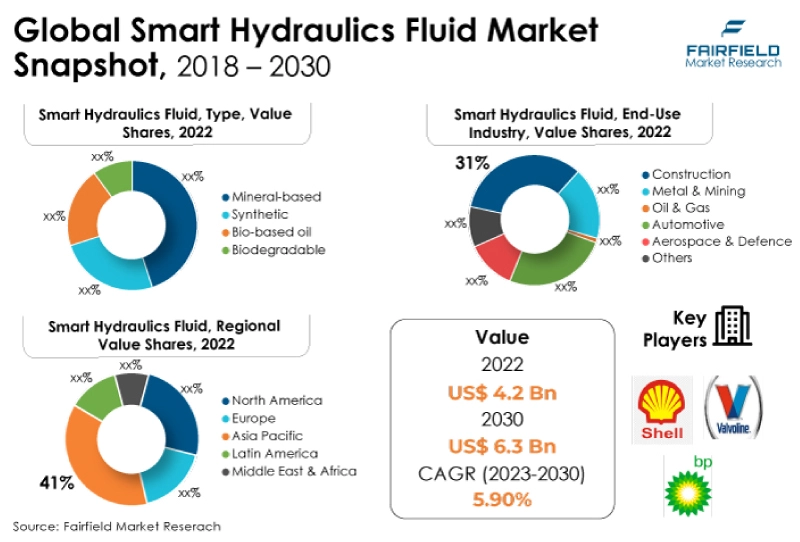
Quick Report Digest
- The increasing adoption of industrial automation across many industries is driving the demand for smart hydraulic fluids, which play an important role in improving the efficiency and precision of automated hydraulic systems.
- Sensor technology, data analytics, and smart features advancements have led to the creation of novel smart hydraulics fluids, attracting companies looking to optimize their hydraulic operations.
- With increased environmental awareness, companies are moving to eco-friendly solutions, and smart hydraulics fluids, known for their long-term sustainability and low environmental effects, are gaining appeal.
- The combination of smart hydraulic fluids and Internet of Things (IoT) technology opens prospects for expanded data monitoring, predictive maintenance, and increased system efficiency, resulting in increased market demand.
- In 2022, the mineral oil category controlled the market. Due to increased environmental concerns and restrictions, the market is seeing a move towards eco-friendly alternatives, resulting in a gradual shift towards more sustainable options.
- In 2022, the construction segment dominated the market. The growing demand for precision and automation in construction processes encourages the use of smart hydraulic fluids. Real-time monitoring and predictive maintenance provide optimised performance and reduced downtime, increasing construction productivity.
- The Asia Pacific region is expected to acquire the largest share of the global Smart Hydraulics Fluid market. The region's emphasis on automation and sustainability is propelling the use of smart hydraulic fluids across various industries, including industrial, automotive, and aerospace.
- The market for smart hydraulics fluid is expanding in Europe. Shell plc, BP plc, TotalEnergies, and LUKOIL are the leading hydraulic fluid companies in the region. Europe is an important region for the construction and automotive sectors.
A Look Back and a Look Forward - Comparative Analysis
The market's expansion can be attributed to increased infrastructure and development activity around the world. Governments in underdeveloped countries are focusing on infrastructure development. Factors such as the availability of finance, a focus on operational resilience, the deployment of new technologies, and the affordability of infrastructure are all contributing to the increase in infrastructure activity.
The market was impacted in terms of production, distribution, and supply in 2020 due to the spread of Coronavirus. Base oil prices fell precipitously due to a lack of supply and demand from end-use sectors. During the epidemic, restrictions on material and personnel transportation brought the above industry to a halt.
The Russia-Ukraine war in 2022 has further damaged the hydraulic fluids market's supply chain. Russia is one of the world's major producers of base oil. The reduction in base oil imports from Russia by several countries has had a significant impact on hydraulic fluid costs. Several corporations have raised base oil prices by 15% in comparison to previous years.
Rapid industrialisation in emerging nations opens new market prospects as these regions seek innovative hydraulic solutions to boost productivity and efficiency, fostering the expansion of smart hydraulics fluids.
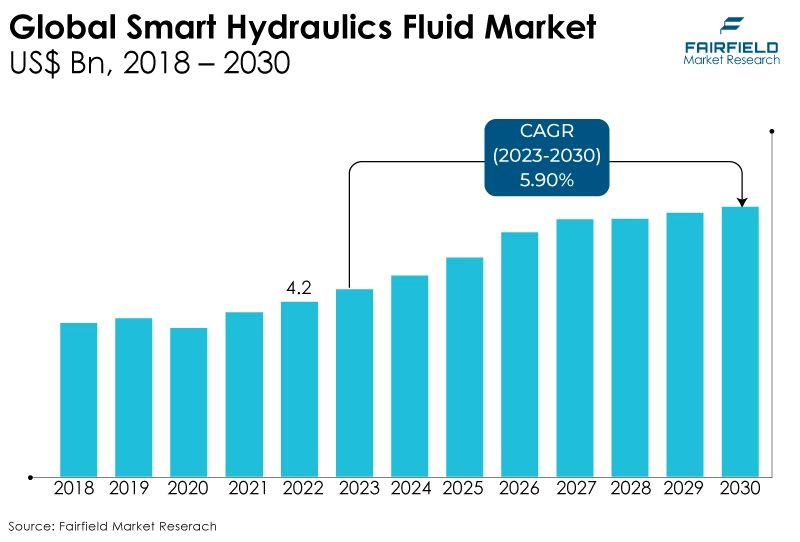
Key Growth Determinants
- Increased Demand for Hydraulic Oils
Demand for various types of hydraulic systems is continually increasing as the modern industry requires faster speeds and efficiency at higher working pressures and temperatures. Hydraulic oils perform lubrication, energy transmission, and heat removal from mechanical components. The increase in industrial expansion will accelerate the rate of growth of the hydraulic oil market.
Improved hydraulic fluid quality will also boost market value increase. Furthermore, Group II and III base oils are suited for use in lubricant formulations for automatic gearbox engines, heavy-duty vehicles, and passenger autos, and different qualities of Group II and III base oils are expected to drive market expansion.
- Growing Adoption Across Industries
The market for hydraulic fluids is expanding because of the increased use of hydraulic equipment in a variety of industries, including the construction and automobile industries. Hydraulic systems are commonly employed in tough applications since they are designed to perform in high temperatures, high pressures, and other demanding situations, which promotes market growth.
The market is developing due to the increasing use of hydraulic fluid to decrease component wear and tear, protect internal systems from corrosion, and prevent erosion of the external environment.
- Consistently Reducing Fuel Consumption
Hydraulic fluids must keep up with the requirement for higher operational speeds and pressures, increasing electronic use, and improved precision and accuracy in operation. Straight-grade fluids are ideal for temperature-controlled industrial machines. Fuel efficiency is determined by hydraulic fluid temperature, viscosity, and shear stability; multi-grade hydraulic fluids can improve fuel economy.
Energy-efficient hydraulic fluids are becoming more significant and widely available around the world. The end user finds hydraulic fluids appealing due to the sustainability trend and fundamental cost considerations. Total Lubricants, for example, just announced a new high-performance hydraulic fluid designed with Dynavis Technology. The fluid promises several substantial advantages, including improved fuel economy. Hydraulic fluids lowered fuel usage by 5-30% in field tests.
Major Growth Barriers
- Increasing Inclination Toward EVs
The electrification of industrial equipment and transportation is a significant impediment to market expansion. The rapid movement in customer preferences towards electric vehicles may have a negative influence on market growth.
Consumers' tastes are fast shifting from fossil fuels to renewable sources of energy as they become more conscious of the environmental impact. Furthermore, the government has imposed rigorous automobile emission standards in several regions.
Manufacturers have responded by drastically reducing overall vehicle weight by minimising the usage of heavy mechanisms, components, and materials.
- Price Instabilities
Price changes in raw materials will be detrimental to the hydraulic oil industry. This will put the hydraulic oil market's growth rate under pressure. This hydraulic oil market report details new recent developments, trade regulations, import-export analysis, production analysis, value chain optimisation, market share, the impact of domestic and localised market players, analyses opportunities in terms of emerging revenue pockets, changes in market regulations, strategic market growth analysis, market size, category market growths, application niches and dominance, product approvals, product launches, geographies, and product approvals, product launches, geographies.
Key Trends and Opportunities to Look at
- Enhancing Hydraulic System Technologies
Hydraulic fluids generated from renewable sources, such as vegetable oils and animal fats, are in high demand. Because of their minimal environmental effect and biodegradability, bio-based hydraulic fluids are gaining appeal.
Intelligent hydraulic systems, which use sensors and control systems to optimize hydraulic system performance, are a significant leap in hydraulic system technology. These systems can assist in lowering energy consumption, increasing efficiency, and extending the life of hydraulic components. High-pressure hydraulic systems are in high demand across multiple industries, including construction, mining, & oil and gas.
- Growing Energy Efficiency
Hydraulic fluids containing friction-reducing additives can assist in minimising energy consumption by lowering the amount of energy required to move hydraulic components. High-temperature hydraulic fluids can assist in minimising energy consumption by lowering the requirement for cooling systems to keep hydraulic components at safe operating temperatures.
Hydraulic fluids can be optimised for specific hydraulic systems, resulting in increased efficiency and reduced energy use. Because of their minimal environmental impact and energy-efficient features, bio-based hydraulic fluids made from renewable sources are gaining appeal.
- Applications Across Various Industries
Smart hydraulics fluids have the potential to increase safety, performance, and fuel efficiency in the transportation sector, including railways and marine applications, while also adapting to the increasing needs of modern transportation systems.
High-performance and dependable hydraulic systems are sought after by the aerospace and defense industries. Smart hydraulic fluids with sophisticated features can improve the performance of aviation and military equipment, opening new business prospects in this crucial sector.
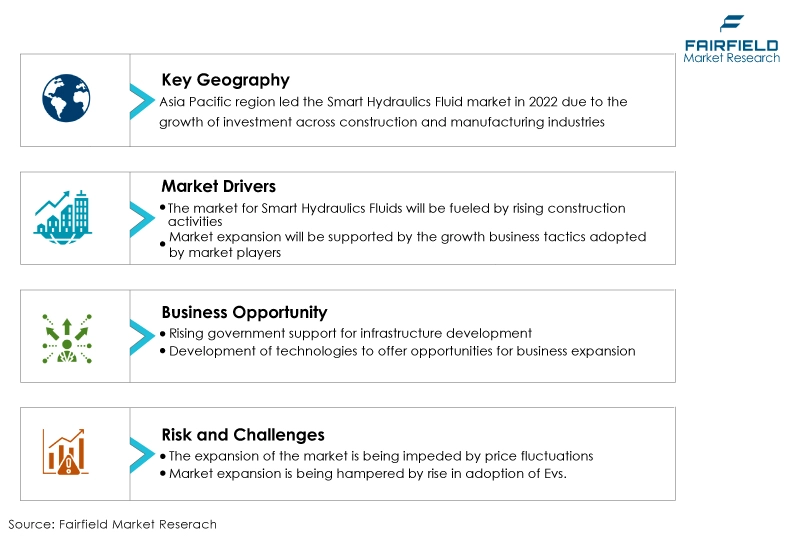
How Does the Regulatory Scenario Shape this Industry?
Over the last three years, the government has invested in the development of industrial sectors across various regions which is helping the market to expand in the forecasted period. The Chinese construction sector was worth approximately US$1,049.2 Bn in 2020. This industry is expected to be worth around US$1,117.4 Bn by 2021, with a 6.5% growth rate.
In 2019, new construction projects in Japan occupied 127.55 million square meters. This fell to roughly 113.74 million square meters in 2020, representing a 10.5% reduction. Both residential and commercial development in India has increased as the country's service sector has grown.
The Indian government announced an investment of approximately US$27.54 Bn for the development of 100 cities under the smart cities plan, according to the Ministry of Housing and Urban Affairs. This strategy covers 5,151 distinct smart city projects. As of April 2021, 1,638 of these projects had been completed.
Fairfield’s Ranking Board
Top Segments
- Mineral/Petroleum Oil Category Outweighs Synthetic Counterpart
The mineral oil category dominated the hydraulic fluids market. Mineral oil is the most south-after base oil in hydraulic fluid production and is divided among three groups: Group I, Group II, and Group III. Mineral oil that has been solvent-refined belongs to Group I.
The most prevalent base stock for modern hydraulic fluids is Group I base mineral oil. Other base stocks, like silicone oils or propylene glycol, may be needed for specific applications.
The CAGR for synthetic oil is predicted to be the highest. Synthetic hydraulic oil was developed to address the shortcomings of mineral hydraulic oil. Because they are made of chemically created base oils, they outperform mineral hydraulic fluids. The most prevalent advantage of synthetic fluids is that they last longer.
BASF SE, a worldwide known firm, said in March 2022 that it would enhance its synthetic ester base stock manufacturing capacity at its Jinshan, China, site. The investment is in response to Asia Pacific's increased demand for high-performance lubricants.
- Construction will Surge Ahead
In 2022, the construction category dominated the market. Hydraulic construction equipment accounts for 76% of the hydraulic equipment industry, according to the Society of Tribologists and Lubrication Engineers (STLE). It might be challenging to maintain operational flow and end-activity amid often uncontrolled construction scenarios.
Lubricants, according to Valvoline, account for 1 to 3% of the construction equipment maintenance costs. Construction machinery must be reliable and available to meet strict deadlines without jeopardising the bottom line and profitability.
The automotive segment is expanding at the fastest CAGR over the anticipated period. The increase in off-highway vehicle production and sales is predicted to drive up demand for hydraulic fluids in the automotive industry over the forecast period.
Furthermore, technical advancements in vehicle braking and suspension systems, as well as the increasing acceptance of electronics in automobiles, are likely to drive market expansion.
Regional Frontrunners
Asia Pacific Contributes the Largest Revenue
Asia Pacific dominated the smart hydraulic fluids market, accounting for the majority of revenue share. China, Japan, India, and Australia are major markets in the Asia Pacific.
Rising manufacturing and construction investments, SME growth, and the rise of new local and foreign companies are some of the reasons boosting regional demand for industrial lubricants. Furthermore, rising passenger and commercial vehicle sales in the region, as well as increased demand for synthetic lubricants, are driving market expansion.
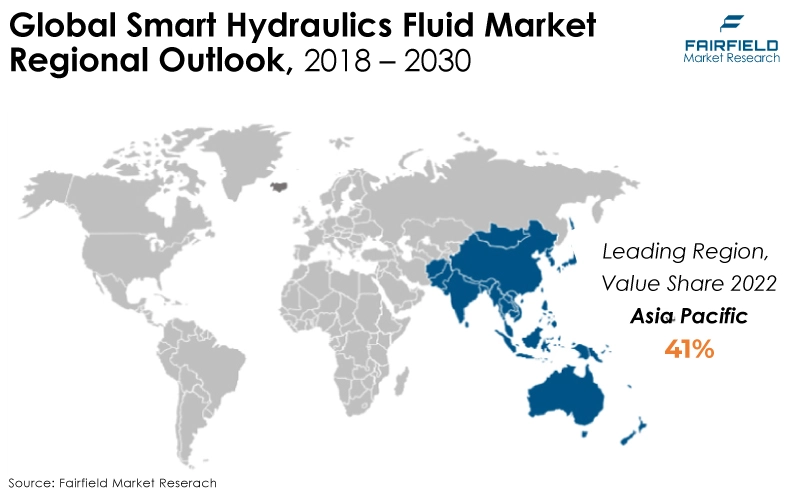
Europe Likely to Witness the Significant Growth in Sales
The smart hydraulic fluids market accounted for the second-greatest revenue share in Europe. Europe is a critical location for the building and automobile industries. The region's demand for hydraulic fluids is predicted to be high over the forecast period.
In 2020, the European Union imported prepared hydraulic gearbox and brake fluids that either did not include any petroleum oils or bituminous mineral oils or did so in amounts less than 70% by weight of such substances. The price of the transaction was US$88,641.30.
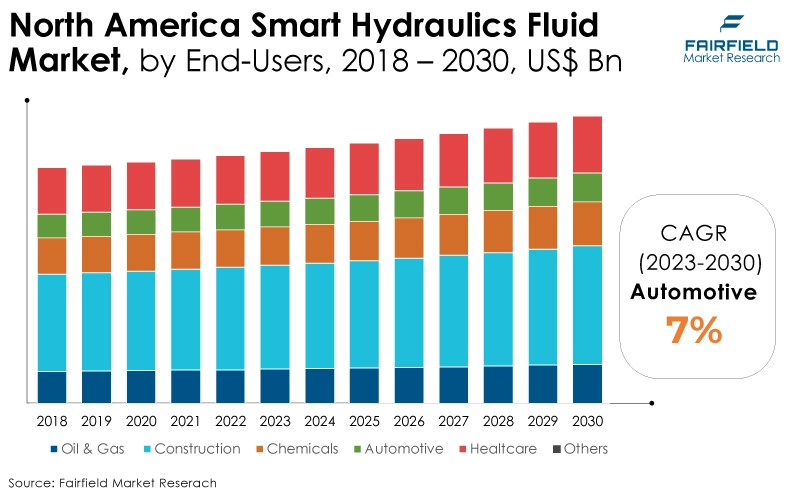
Fairfield’s Competitive Landscape Analysis
The global smart hydraulics fluid market is a consolidated market with fewer major players present across the globe. The key players are introducing new products as well as working on the distribution channels to enhance their worldwide presence. Moreover, Fairfield Market Research is expecting the market to witness more consolidation over the coming years.
Who are the Leaders in Global Smart Hydraulics Fluid Space?
- ExxonMobil Corporation
- Royal Dutch Shell plc
- Chevron Corporation
- TotalEnergies SE
- BP plc
- BASF SE
- Lukoil
- Valvoline Inc.
- Castrol Limited
- FUCHS Group
- PetroChina Company Ltd.
- Idemitsu Kosan Co., Ltd.
- China Petrochemical Corporation
- NYCO
- Vitesco Technologies GmbH
Significant Company Developments
Mergers and Acquisitions
- July 2021: TotalEnergies purchased Enerfluid, a firm that specialises in smart hydraulics fluid technology for renewable energy applications. This acquisition strengthened TotalEnergies' position in the renewable energy market, allowing them to offer innovative smart hydraulics solutions for wind turbines and solar power plants.
- June 2021: The FUCHS Group, a global lubricants company, signed an agreement to acquire Gleitmo Technik AB's lubricants business in Kungsbacka, Sweden, on July 1, 2021, and integrate it into its subsidiary FUCHS LUBRICANTS SWEDEN AB
- March 2018: A Florida-based company called EndFlex, which makes secondary and end-of-line automatic packaging systems, including case erecting, has introduced the PKR modular pick and place cell with delta robot to its collection of case and tray packing equipment. The PKR Delta is a pick-and-place packaging option for flexible bags and packages, complementing the PKR Gantry, which is made to pack more rigid cans, cartons, jars, bottles, and similarly packaged goods.
Market Developments
- May 2023: Alpha-Web filtration medium has been released by Donaldson Company, Inc. This revolutionary hydraulic filtering technique greatly increases hydraulic fluid purity, which can lengthen the life of hydraulic components, reduce downtime, and reduce the cost of equipment ownership.
- November 2019: Total has introduced a line of recycled hydraulic fluids for industrial application. These are appropriate for all types of industrial hydraulic systems.
An Expert’s Eye
Market Demand and Future Growth
As per Fairfield’s Analysis, the increased demand for heavy equipment is expected to drive market expansion. Heavy machinery demand is a major driver of the hydraulic fluid industry. Hydraulic fluid is utilised as a power transmission medium in hydraulic systems found in large machinery such as construction equipment, agricultural gear, and ships.
However, the smart hydraulics fluid market is expected to face considerable challenges because of environmental concerns and changing raw material prices.
Supply Side of the Market
According to our analysis, companies compete in the market through a variety of techniques, including product development, mergers and acquisitions, and alliances. ExxonMobil Corporation, and Siemens, for example, formed a significant cooperation in the smart hydraulics fluid market in 2021 to incorporate smart sensors and data analytics into their hydraulic fluid supplies, boosting customers' real-time monitoring and predictive maintenance capabilities.
Several new players with a focus on innovation and development have entered the smart hydraulics fluid market. These new companies invest in research and cutting-edge technology to provide innovative smart hydraulic fluids with enhanced features such as real-time monitoring, predictive maintenance, and greater sustainability.
Global Smart Hydraulics Fluid Market is Segmented as Below:
By Type:
- Mineral/Petroleum-based
- Synthetic-based
- Water-based
- Biodegradable
By End-use Industry:
- Construction
- Chemicals
- Oil & Gas
- Automotive
- Healthcare
- Others
By Geographic Coverage:
- North America
- U.S.
- Canada
- Europe
- Germany
- U.K.
- France
- Italy
- Turkey
- Russia
- Rest of Europe
- Asia Pacific
- China
- Japan
- South Korea
- India
- Southeast Asia
- Rest of Asia Pacific
- Latin America
- Brazil
- Mexico
- Argentina
- Rest of Latin America
- Middle East & Africa
- GCC
- South Africa
- Egypt
- Nigeria
- Rest of the Middle East & and Africa
1. Executive Summary
1.1. Global Smart Hydraulics Fluid Market Snapshot
1.2. Future Projections
1.3. Key Market Trends
1.4. Regional Snapshot, by Value, 2022
1.5. Analyst Recommendations
2. Market Overview
2.1. Market Definitions and Segmentations
2.2. Market Dynamics
2.2.1. Drivers
2.2.2. Restraints
2.2.3. Market Opportunities
2.3. Value Chain Analysis
2.4. Porter’s Five Forces Analysis
2.5. Covid-19 Impact Analysis
2.5.1. Supply
2.5.2. Demand
2.6. Impact of Ukraine-Russia Conflict
2.7. Economic Overview
2.7.1. World Economic Projections
2.8. PESTLE Analysis
3. Global Smart Hydraulics Fluid Market Outlook, 2018 - 2030
3.1. Global Smart Hydraulics Fluid Market Outlook, by Type, Value (US$ Bn), 2018 - 2030
3.1.1. Key Highlights
3.1.1.1. Mineral/Petroleum-based
3.1.1.2. Synthetic-based
3.1.1.3. Water-based
3.1.1.4. Biodegradable
3.2. Global Smart Hydraulics Fluid Market Outlook, by End use Industry, Value (US$ Bn), 2018 - 2030
3.2.1. Key Highlights
3.2.1.1. Construction
3.2.1.2. Chemicals
3.2.1.3. Oil & gas
3.2.1.4. Automotive
3.2.1.5. Healthcare
3.2.1.6. Others
3.3. Global Smart Hydraulics Fluid Market Outlook, by Region, Value (US$ Bn), 2018 - 2030
3.3.1. Key Highlights
3.3.1.1. North America
3.3.1.2. Europe
3.3.1.3. Asia Pacific
3.3.1.4. Latin America
3.3.1.5. Middle East & Africa
4. North America Smart Hydraulics Fluid Market Outlook, 2018 - 2030
4.1. North America Smart Hydraulics Fluid Market Outlook, by Type, Value (US$ Bn), 2018 - 2030
4.1.1. Key Highlights
4.1.1.1. Mineral/Petroleum-based
4.1.1.2. Synthetic-based
4.1.1.3. Water-based
4.1.1.4. Biodegradable
4.2. North America Smart Hydraulics Fluid Market Outlook, by End use Industry, Value (US$ Bn), 2018 - 2030
4.2.1. Key Highlights
4.2.1.1. Construction
4.2.1.2. Chemicals
4.2.1.3. Oil & gas
4.2.1.4. Automotive
4.2.1.5. Healthcare
4.2.1.6. Others
4.2.2. BPS Analysis/Market Attractiveness Analysis
4.3. North America Smart Hydraulics Fluid Market Outlook, by Country, Value (US$ Bn), 2018 - 2030
4.3.1. Key Highlights
4.3.1.1. U.S. Smart Hydraulics Fluid Market, by Type, Value (US$ Bn), 2018 - 2030
4.3.1.2. U.S. Smart Hydraulics Fluid Market, by End use Industry, Value (US$ Bn), 2018 - 2030
4.3.1.3. Canada Smart Hydraulics Fluid Market, by Type, Value (US$ Bn), 2018 - 2030
4.3.1.4. Canada Smart Hydraulics Fluid Market, by End use Industry, Value (US$ Bn), 2018 - 2030
4.3.2. BPS Analysis/Market Attractiveness Analysis
5. Europe Smart Hydraulics Fluid Market Outlook, 2018 - 2030
5.1. Europe Smart Hydraulics Fluid Market Outlook, by Type, Value (US$ Bn), 2018 - 2030
5.1.1. Key Highlights
5.1.1.1. Mineral/Petroleum-based
5.1.1.2. Synthetic-based
5.1.1.3. Water-based
5.1.1.4. Biodegradable
5.2. Europe Smart Hydraulics Fluid Market Outlook, by End use Industry, Value (US$ Bn), 2018 - 2030
5.2.1. Key Highlights
5.2.1.1. Construction
5.2.1.2. Chemicals
5.2.1.3. Oil & gas
5.2.1.4. Automotive
5.2.1.5. Healthcare
5.2.1.6. Others
5.2.2. BPS Analysis/Market Attractiveness Analysis
5.3. Europe Smart Hydraulics Fluid Market Outlook, by Country, Value (US$ Bn), 2018 - 2030
5.3.1. Key Highlights
5.3.1.1. Germany Smart Hydraulics Fluid Market, by Type, Value (US$ Bn), 2018 - 2030
5.3.1.2. Germany Smart Hydraulics Fluid Market, by End use Industry, Value (US$ Bn), 2018 - 2030
5.3.1.3. U.K. Smart Hydraulics Fluid Market, by Type, Value (US$ Bn), 2018 - 2030
5.3.1.4. U.K. Smart Hydraulics Fluid Market, by End use Industry, Value (US$ Bn), 2018 - 2030
5.3.1.5. France Smart Hydraulics Fluid Market, by Type, Value (US$ Bn), 2018 - 2030
5.3.1.6. France Smart Hydraulics Fluid Market, by End use Industry, Value (US$ Bn), 2018 - 2030
5.3.1.7. Italy Smart Hydraulics Fluid Market, by Type, Value (US$ Bn), 2018 - 2030
5.3.1.8. Italy Smart Hydraulics Fluid Market, by End use Industry, Value (US$ Bn), 2018 - 2030
5.3.1.9. Turkey Smart Hydraulics Fluid Market, by Type, Value (US$ Bn), 2018 - 2030
5.3.1.10. Turkey Smart Hydraulics Fluid Market, by End use Industry, Value (US$ Bn), 2018 - 2030
5.3.1.11. Russia Smart Hydraulics Fluid Market, by Type, Value (US$ Bn), 2018 - 2030
5.3.1.12. Russia Smart Hydraulics Fluid Market, by End use Industry, Value (US$ Bn), 2018 - 2030
5.3.1.13. Rest of Europe Smart Hydraulics Fluid Market, by Type, Value (US$ Bn), 2018 - 2030
5.3.1.14. Rest of Europe Smart Hydraulics Fluid Market, by End use Industry, Value (US$ Bn), 2018 - 2030
5.3.2. BPS Analysis/Market Attractiveness Analysis
6. Asia Pacific Smart Hydraulics Fluid Market Outlook, 2018 - 2030
6.1. Asia Pacific Smart Hydraulics Fluid Market Outlook, by Type, Value (US$ Bn), 2018 - 2030
6.1.1. Key Highlights
6.1.1.1. Mineral/Petroleum-based
6.1.1.2. Synthetic-based
6.1.1.3. Water-based
6.1.1.4. Biodegradable
6.2. Asia Pacific Smart Hydraulics Fluid Market Outlook, by End use Industry, Value (US$ Bn), 2018 - 2030
6.2.1. Key Highlights
6.2.1.1. Construction
6.2.1.2. Chemicals
6.2.1.3. Oil & gas
6.2.1.4. Automotive
6.2.1.5. Healthcare
6.2.1.6. Others
6.2.2. BPS Analysis/Market Attractiveness Analysis
6.3. Asia Pacific Smart Hydraulics Fluid Market Outlook, by Country, Value (US$ Bn), 2018 - 2030
6.3.1. Key Highlights
6.3.1.1. China Smart Hydraulics Fluid Market, by Type, Value (US$ Bn), 2018 - 2030
6.3.1.2. China Smart Hydraulics Fluid Market, by End use Industry, Value (US$ Bn), 2018 - 2030
6.3.1.3. Japan Smart Hydraulics Fluid Market, by Type, Value (US$ Bn), 2018 - 2030
6.3.1.4. Japan Smart Hydraulics Fluid Market, by End use Industry, Value (US$ Bn), 2018 - 2030
6.3.1.5. South Korea Smart Hydraulics Fluid Market, by Type, Value (US$ Bn), 2018 - 2030
6.3.1.6. South Korea Smart Hydraulics Fluid Market, by End use Industry, Value (US$ Bn), 2018 - 2030
6.3.1.7. India Smart Hydraulics Fluid Market, by Type, Value (US$ Bn), 2018 - 2030
6.3.1.8. India Smart Hydraulics Fluid Market, by End use Industry, Value (US$ Bn), 2018 - 2030
6.3.1.9. Southeast Asia Smart Hydraulics Fluid Market, by Type, Value (US$ Bn), 2018 - 2030
6.3.1.10. Southeast Asia Smart Hydraulics Fluid Market, by End use Industry, Value (US$ Bn), 2018 - 2030
6.3.1.11. Rest of Asia Pacific Smart Hydraulics Fluid Market, by Type, Value (US$ Bn), 2018 - 2030
6.3.1.12. Rest of Asia Pacific Smart Hydraulics Fluid Market, by End use Industry, Value (US$ Bn), 2018 - 2030
6.3.2. BPS Analysis/Market Attractiveness Analysis
7. Latin America Smart Hydraulics Fluid Market Outlook, 2018 - 2030
7.1. Latin America Smart Hydraulics Fluid Market Outlook, by Type, Value (US$ Bn), 2018 - 2030
7.1.1. Key Highlights
7.1.1.1. Mineral/Petroleum-based
7.1.1.2. Synthetic-based
7.1.1.3. Water-based
7.1.1.4. Biodegradable
7.2. Latin America Smart Hydraulics Fluid Market Outlook, by End use Industry, Value (US$ Bn), 2018 - 2030
7.2.1. Key Highlights
7.2.1.1. Construction
7.2.1.2. Chemicals
7.2.1.3. Oil & gas
7.2.1.4. Automotive
7.2.1.5. Healthcare
7.2.1.6. Others
7.2.2. BPS Analysis/Market Attractiveness Analysis
7.3. Latin America Smart Hydraulics Fluid Market Outlook, by Country, Value (US$ Bn), 2018 - 2030
7.3.1. Key Highlights
7.3.1.1. Brazil Smart Hydraulics Fluid Market, by Type, Value (US$ Bn), 2018 - 2030
7.3.1.2. Brazil Smart Hydraulics Fluid Market, by End use Industry, Value (US$ Bn), 2018 - 2030
7.3.1.3. Mexico Smart Hydraulics Fluid Market, by Type, Value (US$ Bn), 2018 - 2030
7.3.1.4. Mexico Smart Hydraulics Fluid Market, by End use Industry, Value (US$ Bn), 2018 - 2030
7.3.1.5. Argentina Smart Hydraulics Fluid Market, by Type, Value (US$ Bn), 2018 - 2030
7.3.1.6. Argentina Smart Hydraulics Fluid Market, by End use Industry, Value (US$ Bn), 2018 - 2030
7.3.1.7. Rest of Latin America Smart Hydraulics Fluid Market, by Type, Value (US$ Bn), 2018 - 2030
7.3.1.8. Rest of Latin America Smart Hydraulics Fluid Market, by End use Industry, Value (US$ Bn), 2018 - 2030
7.3.2. BPS Analysis/Market Attractiveness Analysis
8. Middle East & Africa Smart Hydraulics Fluid Market Outlook, 2018 - 2030
8.1. Middle East & Africa Smart Hydraulics Fluid Market Outlook, by Type, Value (US$ Bn), 2018 - 2030
8.1.1. Key Highlights
8.1.1.1. Mineral/Petroleum-based
8.1.1.2. Synthetic-based
8.1.1.3. Water-based
8.1.1.4. Biodegradable
8.2. Middle East & Africa Smart Hydraulics Fluid Market Outlook, by End use Industry, Value (US$ Bn), 2018 - 2030
8.2.1. Key Highlights
8.2.1.1. Construction
8.2.1.2. Chemicals
8.2.1.3. Oil & gas
8.2.1.4. Automotive
8.2.1.5. Healthcare
8.2.1.6. Others
8.2.2. BPS Analysis/Market Attractiveness Analysis
8.3. Middle East & Africa Smart Hydraulics Fluid Market Outlook, by Country, Value (US$ Bn), 2018 - 2030
8.3.1. Key Highlights
8.3.1.1. GCC Smart Hydraulics Fluid Market, by Type, Value (US$ Bn), 2018 - 2030
8.3.1.2. GCC Smart Hydraulics Fluid Market, by End use Industry, Value (US$ Bn), 2018 - 2030
8.3.1.3. South Africa Smart Hydraulics Fluid Market, by Type, Value (US$ Bn), 2018 - 2030
8.3.1.4. South Africa Smart Hydraulics Fluid Market, by End use Industry, Value (US$ Bn), 2018 - 2030
8.3.1.5. Egypt Smart Hydraulics Fluid Market, by Type, Value (US$ Bn), 2018 - 2030
8.3.1.6. Egypt Smart Hydraulics Fluid Market, by End use Industry, Value (US$ Bn), 2018 - 2030
8.3.1.7. Nigeria Smart Hydraulics Fluid Market, by Type, Value (US$ Bn), 2018 - 2030
8.3.1.8. Nigeria Smart Hydraulics Fluid Market, by End use Industry, Value (US$ Bn), 2018 - 2030
8.3.1.9. Rest of Middle East & Africa Smart Hydraulics Fluid Market, by Type, Value (US$ Bn), 2018 - 2030
8.3.1.10. Rest of Middle East & Africa Smart Hydraulics Fluid Market, by End use Industry, Value (US$ Bn), 2018 - 2030
8.3.2. BPS Analysis/Market Attractiveness Analysis
9. Competitive Landscape
9.1. Manufacturer vs Type Heatmap
9.2. Company Market Share Analysis, 2022
9.3. Competitive Dashboard
9.4. Company Profiles
9.4.1. ExxonMobil Corporation
9.4.1.1. Company Overview
9.4.1.2. Product Portfolio
9.4.1.3. Financial Overview
9.4.1.4. Business Strategies and Development
9.4.2. Royal Dutch Shell plc
9.4.2.1. Company Overview
9.4.2.2. Product Portfolio
9.4.2.3. Financial Overview
9.4.2.4. Business Strategies and Development
9.4.3. Chevron Corporation
9.4.3.1. Company Overview
9.4.3.2. Product Portfolio
9.4.3.3. Financial Overview
9.4.3.4. Business Strategies and Development
9.4.4. TotalEnergies SE
9.4.4.1. Company Overview
9.4.4.2. Product Portfolio
9.4.4.3. Financial Overview
9.4.4.4. Business Strategies and Development
9.4.5. BP p.l.c.
9.4.5.1. Company Overview
9.4.5.2. Product Portfolio
9.4.5.3. Financial Overview
9.4.5.4. Business Strategies and Development
9.4.6. BASF SE
9.4.6.1. Company Overview
9.4.6.2. Product Portfolio
9.4.6.3. Financial Overview
9.4.6.4. Business Strategies and Development
9.4.7. Lukoil
9.4.7.1. Company Overview
9.4.7.2. Product Portfolio
9.4.7.3. Financial Overview
9.4.7.4. Business Strategies and Development
9.4.8. Valvoline, Inc.
9.4.8.1. Company Overview
9.4.8.2. Product Portfolio
9.4.8.3. Business Strategies and Development
9.4.9. Castrol Limited
9.4.9.1. Company Overview
9.4.9.2. Product Portfolio
9.4.9.3. Financial Overview
9.4.9.4. Business Strategies and Development
9.4.10. FUCHS Group
9.4.10.1. Company Overview
9.4.10.2. Product Portfolio
9.4.10.3. Financial Overview
9.4.10.4. Business Strategies and Development
9.4.11. PetroChina Company Ltd.
9.4.11.1. Company Overview
9.4.11.2. Product Portfolio
9.4.11.3. Financial Overview
9.4.11.4. Business Strategies and Development
9.4.12. Idemitsu Kosan Co., Ltd.
9.4.12.1. Company Overview
9.4.12.2. Product Portfolio
9.4.12.3. Financial Overview
9.4.12.4. Business Strategies and Development
9.4.13. China Petrochemical Corporation
9.4.13.1. Company Overview
9.4.13.2. Product Portfolio
9.4.13.3. Financial Overview
9.4.13.4. Business Strategies and Development
9.4.14. NYCO
9.4.14.1. Company Overview
9.4.14.2. Product Portfolio
9.4.14.3. Financial Overview
9.4.14.4. Business Strategies and Development
9.4.15. Vitesco Technologies GmbH
9.4.15.1. Company Overview
9.4.15.2. Product Portfolio
9.4.15.3. Financial Overview
9.4.15.4. Business Strategies and Development
10. Appendix
10.1. Research Methodology
10.2. Report Assumptions
10.3. Acronyms and Abbreviations
|
BASE YEAR |
HISTORICAL DATA |
FORECAST PERIOD |
UNITS |
|||
|
2022 |
|
2018 - 2022 |
2023 - 2030 |
Value: US$ Million |
||
|
REPORT FEATURES |
DETAILS |
|
Type Coverage |
|
|
End-use Industry Coverage |
|
|
Geographical Coverage |
|
|
Leading Companies |
|
|
Report Highlights |
Key Market Indicators, Macro-micro economic impact analysis, Technological Roadmap, Key Trends, Driver, Restraints, and Future Opportunities & Revenue Pockets, Porter’s 5 Forces Analysis, Historical Trend (2019-2021), Market Estimates and Forecast, Market Dynamics, Industry Trends, Competition Landscape, Category, Region, Country-wise Trends & Analysis, COVID-19 Impact Analysis (Demand and Supply Chain) |
